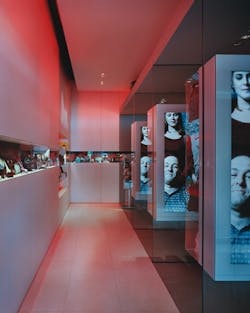Building Fiction: The Architecture of Experience Design
Architecture has always been the home of storytelling. From storing books to creating places for performance, entertainment, worship, sports, commerce, and education, spaces have facilitated the creation of history, fact and fiction.
Today, rather than simply serving as a home for storytelling, architecture becomes a device for storytelling as narratives are woven into its foundations.
Every experience encapsulates stories. While the human mind spins its tales through memory and thoughts, each space—with its history, program, materials, and design—produces a unique set of narratives.
By infusing architecture with digital media, the discipline of experience design hopes to transform static environments into kinetic, cinematic, informative, and interactive spaces that offer an endless anthology of stories.
These stories can be ambient, like the soundtrack of a film or a backdrop to a stage set.
Alternatively, they can be highly narrative and scripted like a Quentin Tarantino film dialogue or a captivating media façade.
Digital media can expand the narrative to include dynamic and personalized storytelling. Wallpaper becomes a silent living painting. A table transforms into a web portal. A poster transitions into a cinema screen.
If, traditionally, electronics in buildings supported air-conditioning systems, televisions, and Internet infrastructures, in their next iteration electronics transform environments into interactive spaces. Adapting to their inhabitants, technology can create and express unique and personalized experiences that change based on real-time changing parameters. These can range from environmental variables to web-based data and individual input.
Adding a virtual dimension to a traditionally static media provides a platform for change, for updatable information, and for curated storytelling.
Experience design is the process of creating such storytelling in space. It transcends the surface and medium to consider every sense and space. Seamlessly integrated into their environments, narratives unfold across different media surfaces and play with perception. Such stories can deliver experiences that are scripted and cinematic as well as highly personalized and choreographed. These exchanges can be passive or interactive, entertaining or informative, didactic or ambient.
Rather than a product, experience design is a hybrid design methodology that merges cinematic storytelling, motion graphics content, emerging technologies, and architecture through a highly collaborative and multidisciplinary process. Bringing together designers, animators, architects, thinkers, filmmakers, producers, writers, technologists, programmers, and futurists, experience design becomes a catalyst for collaboration and innovation.
At their best, these interactive architectures collapse the boundaries between the physical and the virtual, creating magical, time-based experiences that form and transform space and perceptions. Infused by ambient, educational, artistic, commercial, and entertainment content, experience design binds atoms with bytes.
This is not a description of a hypothetical future. As knowledge becomes the most valued global currency, as the world becomes more digitally and visually savvy, and as our expectations of personalization expand beyond our DVRs, cars, and shoes, experience design is permeating our everyday world. Offices, homes, hospitals, stores, museums, airports, hotels, and entertainment and sports venues are all beginning to be cast under the spell. These are the playgrounds of the 21st century where architecture becomes a platform for storytelling.
Imaginary Forces is a multidisciplinary entertainment and design agency based in Hollywood and New York. For the last 6 years, Tali Krakowsky ([email protected]), director of experience design, has worked in concept development and management of the division and its projects on both coasts. She holds a bachelor of arts degree in communication design from the Parsons School of Deign, The New School, New York City, and a master of arts degree from UCLA's School of Architecture, with a thesis on interactive architecture. Krakowsky has played a leading role in projects for Airbus, BMW, IBM, MoMA, and the Grimaldi Forum in Monaco. She gives speeches on experience design worldwide; has written several articles on design, architecture, and innovation; and has taught a class at SCI-Arc in Los Angeles.
